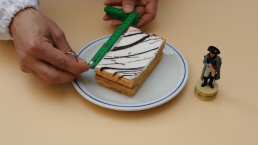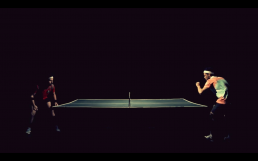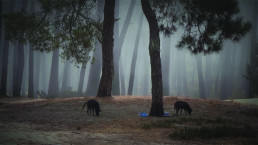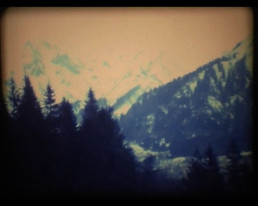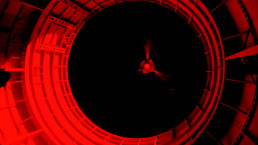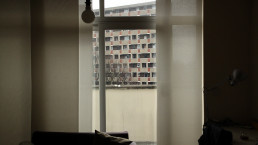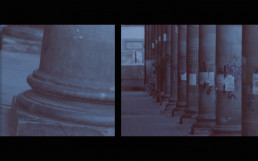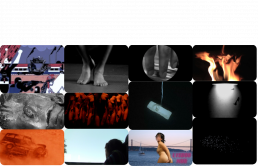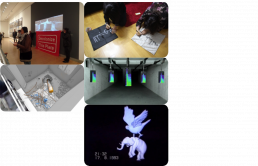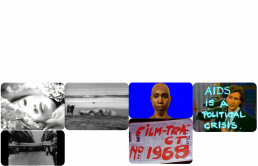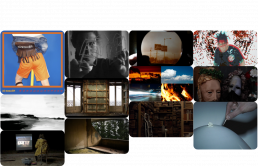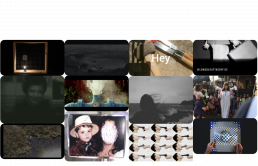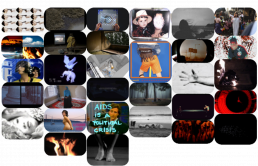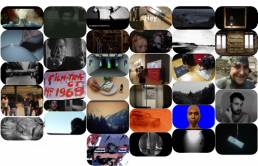“FUSO 2018 – 27 Agosto a 2 Setembro“
30 Agosto, 22h
Museu Nacional de Arte Contemporânea do Chiado (MNAC)
Reload
Curadoria de Marta Mestre
Duração da sessão 57’
Reload faz um ponto de situação sobre a produção dos artistas premiados nas oito edições do FUSO – ANUAL DE VIDEO ARTE INTERNACIONAL DE LISBOA, e procura “carregar baterias” para as próximas edições.
Através de uma seleção cuidadosa, que visa criar diálogos à partida não estabelecidos, foram selecionados trabalhos de treze artistas, privilegiando, sempre que possível, a sua produção recente.
Necessariamente diverso, expressando a produção contemporânea em vídeo, vários dos trabalhos que integram as sessões do MNAC fazem uso de contextos poéticos e políticos, reivindicativos e contemplativos, documentais e ficcionais, cujas fronteiras são naturalmente instáveis.
Raquel Scheffer (PT), Nshajo (O Jogo), 2011, 7’55’’
Entre 1957 e 1960, o antropólogo Jorge Dias, uma das figuras maiores da etnografia colonial portuguesa e da corrente luso-tropicalista, realiza três estudos de campo no Planalto dos Macondes, no Norte de Moçambique. O material recolhido daria origem à extensa monografia Os Macondes de Moçambique (1964-70), uma das obras fundamentais da antropologia portuguesa. Em 1960, aquando da quarta expedição a Moçambique, Jorge Dias permanece durante alguns dias na residência da família da autora, no Mucojo, onde o seu avô era então administrador de posto. Nshajo (O Jogo) entrelaça o relato de um episódio prosaico da estadia de Jorge Dias no Mucojo com uma tentativa de reflexão visual sobre os limites da representação antropológica e os processos de observação empírica, comparação, imitação e aculturação.
Rui Mourão (PT), This is not my voice, 2016, 9’27’’
O vídeo apresenta um questionamento pessoal sobre o papel da arte no atual sistema. Parte da irreverente ocupação “artivista” do MNAC, promovida pelo artista, para explorar alternativas que reaproximem a estética da ética, a arte da sociedade, o eu do outro. Aponta para o potencial ritual da arte nas ligações imagem-corpo e consciência-ação. Na busca, experimenta a transformação.
José Carlos Teixeira (PT), ON EXILE, elsewhere within here, 2018, 25’
No cruzamento entre cinema documental, arte e antropologia, ON EXILE, elsewhere within here investiga conceitos de migração, deslocação e alteridade. Através de entrevistas com refugiados de comunidades muçulmanas do Médio-Oriente e Norte de África, asilados nos Estados Unidos, este filme experimental constrói retratos psicológicos íntimos, inserindo-os num contexto histórico e político determinado. Estética e eticamente empenhado no encontro etnográfico e nas delicadas questões da representação do Outro, o autor procura ouvir e inscrever as vozes dos refugiados, em oposição a um discurso dominante que lhes nega agência ou existência própria. ON EXILE convida-nos, assim, a uma reflexão e um tempo demorados, a um processo necessário de empatia e intersubjetividade – “para nos devolver o Outro, ou nos devolver ao Outro” (J. Pinharanda).
*Esta é uma versão reduzida do original de 70 minutos
José Samões (PT), How to eat a Napoleão, 2017, 2’43’’
Comer como um Português / Eat like a Portuguese é uma série de pequenos vídeos-esquemas que revelam as diferentes maneiras de os portugueses comerem alguns doces tradicionais e outros que se encontram nas pastelarias e cafés no nosso Portugal como o Éclair, a Bola de Berlim, o Jesuíta, o Pastel de Nata, o Napoleão, o Croissant, o Queque, o Bolo de Arroz entre outros quantos através de um subtil humor, um retrato cultural e uma peculiaridade pessoal.
Maciel Santos & João Cruz (PT), Ping Punk King Pong, 2015, 5’42’’
Um palco, público, dois jogadores e muita ação. Tudo isto num curto e empolgante jogo de ping pong que acontece numa sala de espetáculo, onde o improvável se torna real e o jogo transforma-se em algo (im)possível. Ping Punk King Pong é o nome deste vídeo que questiona seriamente, mas de forma “cómica” as nossas crenças.
LealVeileby (PT), The Two-Headed Bull and Other Portuguese Fables, 2017, 7’41’’
Filmado com uma câmara digital portátil e com imperfeições cinematográficas, como grão adicionado na pós-produção, este vídeo utiliza “títulos” da era do cinema mudo para criar um jogo antropomórfico que revela a facilidade com que projetamos traços humanos em tudo à nossa volta através da linguagem. O vídeo lembra-nos de como o texto e a imagem moldam constantemente a nossa compreensão do mundo.
30 Agosto, 23h15
Reload II
Victor Jorge (PT), Landscape, 2013, 2’11’’
Filme found-footage Super8 de 1979, recuperado e restaurado com uma série de movimentos de câmara panorâmicos, numa paisagem com som/música de Lionel Ritchie, All Night Long. Representado nas coleções de arte: coleção privada Ar.Co (Centro de arte e Comunicação Visual) e Fundação EDP Arte/MAAT – Museu de Arte, Arquitetura e Tecnologia, Lisboa e vencedor do prémio de aquisição FUSO/Fundação EDP Arte 2013.
Salomé Lamas (PT), A Torre, 2016, 8′
Talvez a experiência de Kolja de subir ao topo da árvore, de metamorfosear o seu corpo (humano) com a árvore (natureza) aventurando-se na fronteira da terra com o céu, venha confirmar a sua pureza de espírito, a grandiosidade dos idiotas ou a imbecilidade dos místicos. Ou será tudo isto junto? Talvez seja um sintoma dos iluminados ou somente um suicídio elaborado.
Alice dos Reis (PT), The Real Estate Render Blackout, 2017, 9′
Uma identidade anónima induz intencionalmente um corte de energia total no universo dos modelos 3D de Imobiliário de Luxo. Imagens de interiores de luxo em quase escuridão absoluta sucedem-se enquanto as suas personagens virtuais, agências de imobiliário, empresas de construção, consumidores e outras entidades se veem obrigadas a encarar e ajustar-se à escuridão da nova realidade imprevista.
Rita Figueiredo (PT), The Great Attractor, 2017, 9′
The Great Attractor é um filme que parte do mito de Ícaro para explorar a relação entre o humano, o seu planeta e o astro que os ilumina. Dividido em três andamentos, o filme junta imagens em movimento que percorrem o séc. XIX ao séc. XXI, falando secretamente da relação do cinema com a luz, da curiosidade humana sobre o movimento circular dos corpos humanos e celestes, e a destruição dos mesmos.
Bruno Ramos (PT), Better Life, 2013, 6′
Better Life (Uma Vida Melhor) é uma narrativa paralela de duas lutas entre o serviço militar e a cidadania. O áudio capta a história de Bi-rendra M., um nepalês que combateu na Primeira Guerra do Golfo, numa divisão especial do exército britânico, denominada Gurkhas. Esta unidade especial está ativa desde 1857, mas só recentemente os soldados foram autorizados a viver ou visitar o Reino Unido. À medida que ouvimos a sua história, vemos um complexo de habitação social com o nome de James Hammett, um sindicalista da Inglaterra do século XIX, que foi expatriado para a Austrália devido ao seu esforço para melhorar as condições de vida de agricultores.
João Cristóvão Leitão (PT), O Retrato de Irineu, 2014, 4’
Irineu: incapaz de esquecer e dotado de uma memória infalível.
Pedro Matias (PT), I’m the drawing, you’re the reality, 2010, 2’34’’
“Sou sobretudo desenho”. Como artista, ainda me vejo uma pessoa de desenho. Este trabalho é um compromisso e statement mostrando uma nova forma de desenho. Será necessário ter uma folha de papel entre a minha mão e eu? Deverei ser eu o papel dos meus desenhos? Um outro trabalho ainda em aberto, onde eu luto por novas formas de autorretrato, procurando uma nova expressão no meu desenho.
“FUSO 2018 – August 27 to September 2“
August 30, 10pm
Museu Nacional de Arte Contemporânea do Chiado (MNAC)
Reload
Curatorship by Marta Mestre
Total running time 57’
Reload is a survey of work by the artists awarded during the eight editions of FUSO – LISBON INTERNATIONAL ANNUAL VIDEO ART FESTIVAL, and seeks to “recharge its batteries” for future editions.
Through a careful selection, with the aim of opening hereto unestablished dialogues, we have selected works by thirteen artists, always giving priority, whenever possible, to the most recent production of the work. Diverse by default, and showcasing contemporary video production, several of the projects that make up the MNAC sessions make use of poetic and political contexts, the borders of which are naturally unstable, reclaiming and contemplating, either through documentary or fiction.
Raquel Scheffer (PT), Nshajo (The Game), 2011, 7’55’’
Between 1957 and 1960, anthropologist Jorge Dias, one of the main figures of Portuguese colonial ethnography and Luso-Tropicalist Movement, conducted three field studies in the Macondes Plateau, in Northern Mozambique. In 1960, during one of the expeditions to Mozambique, Jorge Dias stayed for some days in my family’s house, in Mucojo, where my grandfather was the post administrator. Nshajo (The Game) articulates the narration of a prosaic episode of Jorge Dias’ stay in Mucojo with an attempt of visual reflection on anthropological representation and the processes of empirical observation, imitation, and acculturation.
Rui Mourão (PT), This is not my voice, 2016, 9’27’’
The video presents a personal questioning of the role of art in the current system. Part of the irreverent “artivist” occupation of MNAC, promoted by the artist, for exploring alternatives that re-establish an aesthetics of ethics, the art of society, the I of the Other. It looks to the potential ritual of art in the image-body and conscience-action connections. Through the search, it attempts transformation.
José Carlos Teixeira (PT), ON EXILE, elsewhere within here, 2018, 25’
At the crossroads between documentary cinema, art and anthropology, ON EXILE, elsewhere within here, investigates the concepts of migration, dislocation and alterity. Through interviews with refugees from Muslim communities from the Middle East and North Africa, exiled in the United States, this experimental film constructs intimate psychological portraits, inserting them into a specific historical and political context. Aesthetically and ethically committed to the ethnographic encounter and to the delicate questions of representation and the Other, the author attempts to listen to and inscribe the voices of the refugees, in opposition to a dominant discourse that denies them agency or their own existence. ON EXILE invites us then, to a lingering reflection and time, to a necessary process of empathy and intersubjectivity – “to return the Other to us, or return us to the Other” (J. Pinharanda).
*This is a 70-minute abridged version of the original
José Samões (PT), How to eat a Napoleão, 2017, 2’43’’
Eat Like a Portuguese is a series of short visual scheme videos that show the different portuguese ways of eating several traditional pastry and others that we can find in pastry and coffee shops in Portugal like an éclair, a jesuíta, a custard tart, a berliner, a croissant, a napoleão, a queque, a bolo de arroz and others. A subtle humour, a lovely portrait of cultural and personal quirks.
Maciel Santos & João Cruz (PT), Ping Punk King Pong, 2015, 5’42’’
A stage, public, two players and a lot of action. All this in a short and exciting ping pong game that takes place in a theatre where the improbable becomes real and the game becomes something (im)possible.
Ping Punk King Pong is the name of this video that make serious questions about our beliefs but in a “comic” way.
LealVeileby (PT), The Two-Headed Bull and Other Portuguese Fables, 2017, 7’41’’
Shot with a portable, digital camera, and incorporating cinematic imperfections, such as a grainy appearance added in post-production, this video uses subtitles from the era of silent film to create an anthropomorphic game which reveals the ease with which we project human traces onto everything that surround us via language. The video reminds us of how the text and the image are constantly shaping our understanding of the world.
August 30, 11:15pm
Reload II
Victor Jorge (PT), Landscape, 2013, 2’11’’
Found-footage Super8 Film from 1979, recovered and restored with a series of panoramic camera movements on a landscape with sound/music from Lionel Ritchie All Night Long. Represented in the art collections: Ar.Co Private Collection (School of Arts and Visual Communication) and EDP ART FOUNDATION/MAAT, Museum of Art, Architecture, and Technology, Lisbon. Winner of the FUSO/EDP ART FOUNDATION 2013 Acquisition Award.
Salomé Lamas (PT), A Torre, 2016, 8′
Perhaps Kolja’s experience of climbing to the top of the tree, of metamorphizing his (human) body with the tree (nature), exploring the boundary between the earth and the heavens, will confirm his purity of spirit, the grandiosity of idiots or the imbecility of mystics. Or is it all of the above? Perhaps it is a sign of the illuminated, or merely an elaborate suicide.
Alice dos Reis (PT), The Real Estate Render Blackout, 2017, 9′
An unknown entity intentionally induces a virtual power cut in all 3D real estate renderings. Views of luxury interiors in almost absolute darkness follow as the environments’ virtual characters, real estate agencies, consumers and other entities are forced to face and adjust to their unexpectedly dark reality.
Rita Figueiredo (PT), The Great Attractor, 2017, 9′
The Great Attractor is a film based on the myth of Icarus, which explores the relationship between the human, its planet, and the star that illuminates them. Divided into three movements, the film combines moving images which range from the 19th to the 21st centuries, covertly addressing the relationship of cinema to light, the human curiosity about the circular motion of human and celestial bodies, and their destruction.
Bruno Ramos (PT), Better Life, 2013, 6′
Better Life tells a twinned narrative of two struggles of service and citizenship. The audio captures the story of Bi-rendra M., a Nepalese man who served in the First Gulf War in a special division of the British army called the Gurkhas. This special unit has been active since 1857, but only recently have these soldiers been allowed to live in or even visit the United Kingdom. As we listen to his story, we see a social housing complex named after James Hammett, a union organizer in 19th-century England who was expatriated to Australia because of his work to improve conditions for farmers.
João Cristóvão Leitão (PT), O Retrato de Irineu, 2014, 4’
Irenaeus: unable to forget and endowed with an infallible memory.
Pedro Matias (PT), I’m the drawing, you’re the reality, 2010, 2’34’’
“I am mostly drawing”. As an artist, I still see myself as a drawing person. This work is a statement and a new way of drawing myself. It’s necessary to have paper between my hand and me? Should I be the paper of my drawings? Another work in progress where I fight with new forms of self-portrait and where I look forward to find a new expression in my drawing.



